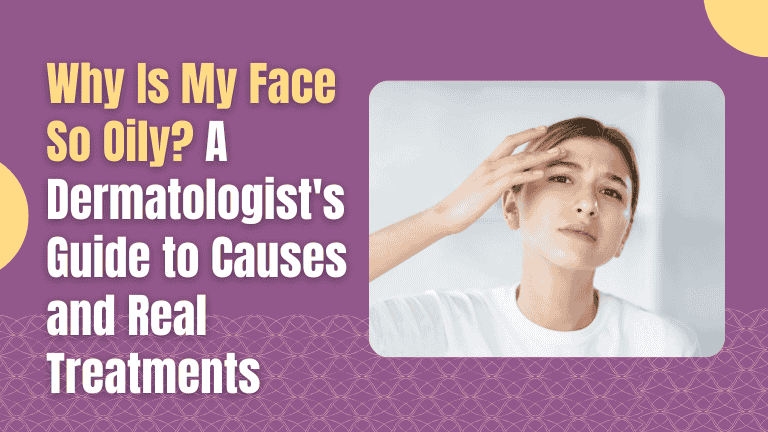Hyperpigmentation: Causes and Treatments
Hyperpigmentation is the darkening of facial skin. It affects millions of people, especially women in India. Causes include sun exposure, hormones, and inflammation. Treatments range from sunscreens to lasers.
Topical agents help by blocking melanin production. Professional peels and light therapies can speed up results. Natural remedies and lifestyle changes support overall skin health. Combining various approaches often yields the best and most lasting results.
1. Understanding Hyperpigmentation
- Hyperpigmentation occurs due to excess melanin in the skin.
- It manifests as dark spots or patches.
- Melasma is a common form of hyperpigmentation, especially among Indian women.
- Up to 30% of middle-aged women may experience melasma.
- Sun exposure significantly increases melanin production.
- Hormonal changes can trigger facial pigmentation.
- Inflammation from conditions like acne can worsen existing spots.
- Genetic factors also influence the severity and pattern of hyperpigmentation.
2. Sunscreen and Sun Protection
- Daily sunscreen use is crucial to prevent new dark spots.
- Use a broad-spectrum sunscreen with SPF 30 or higher.
- Apply approximately half a teaspoon to the face and neck.
- Reapply sunscreen every two hours, especially when outdoors.
- Physical sunscreens containing zinc oxide or titanium dioxide are effective.
- Tinted sunscreens can also block visible light, which contributes to pigmentation.
- Wear hats and seek shade whenever possible.
- Sun avoidance significantly improves the outcomes of hyperpigmentation treatments.
3. Topical Hydroquinone
- Hydroquinone inhibits the enzyme responsible for melanin production.
- It is considered a gold standard treatment for dark spots.
- Hydroquinone creams are available in 2-4% concentrations over-the-counter (OTC) and 4-5% with a prescription.
- Apply twice daily to clean skin.
- Use under the guidance of a dermatologist.
- Short-term use helps limit the risk of ochronosis (a skin discoloration).
- Combine with sunscreen and antioxidants for enhanced results.
4. Retinoids (Vitamin A Derivatives)
- Retinoids accelerate skin cell turnover.
- They help disperse melanin in the epidermis.
- Tretinoin creams can show a reduction in pigmentation within six months.
- Retinol is a gentler, over-the-counter alternative.
- Start with a low concentration and gradually increase it.
- Always use sunscreen when using retinoids.
- Retinoids also improve skin texture.
- They help prevent the formation of new hyperpigmentation.
5. Antioxidants: Vitamin C & Niacinamide
- Vitamin C inhibits melanin production.
- It brightens the skin and fades dark spots.
- Use 10-20% L-ascorbic acid serums.
- Apply in the morning under sunscreen.
- Niacinamide reduces the transfer of pigment within skin cells.
- It soothes inflammation and strengthens the skin barrier.
- Pairing Vitamin C with Vitamin E can create a synergistic effect.
- Antioxidants protect the skin from free radicals.
6. Chemical Peels
- Glycolic, lactic, and mandelic acids are used for exfoliation.
- They gently remove pigmented skin cells.
- Superficial peels may require 3-6 sessions.
- Professional supervision ensures safety.
- Higher-strength peels can lighten stubborn spots.
- Peels also boost collagen production and improve skin tone.
- Downtime varies depending on the depth of the peel.
- Combine with topical agents for better results.
7. Laser and Light Therapies
- Lasers target pigment granules directly.
- Q-switched Nd:YAG laser is a popular choice.
- Intense Pulsed Light (IPL) uses broad-spectrum light pulses.
- These therapies break down pigment for removal by the body’s immune system.
- Multiple sessions, spaced two to four weeks apart, are typically required.
- Physical sunscreens are essential after laser treatments.
- Risks include redness and rebound darkening.
- Best for both dermal and epidermal pigmentation.
8. Microneedling and PRP
- Microneedling creates micro-injuries in the skin.
- It helps disperse pigment and boost collagen production.
- Platelet-Rich Plasma (PRP) can be paired with microneedling for added growth factors.
- Improves skin tone and elasticity.
- Minimal downtime and is relatively cost-effective.
- Safe for darker skin types.
- Sessions are typically spaced four weeks apart.
- Combine with topical depigmenting creams.
9. Oral Treatments
- Tranexamic acid reduces melanin synthesis.
- A typical dose is 250 mg twice daily for 8 weeks.
- Polypodium leucotomos extract is an antioxidant.
- It protects against UV-induced pigmentation.
- Oral procyanidin, combined with vitamins A, C, and E, has shown effectiveness in small trials.
- Consult a doctor before starting any oral treatments.
- Monitor for side effects regularly.
10. Natural Remedies & Lifestyle
- Licorice and kojic acid can lighten spots naturally.
- Green tea extract also reduces melanin production.
- Eat antioxidant-rich fruits and vegetables.
- Stay hydrated for healthy skin.
- Avoid picking at acne to prevent post-inflammatory hyperpigmentation (PIH).
- Adequate sleep and stress management aid skin healing.
- Regular, gentle exfoliation helps remove dead skin cells.
- Use mild cleansers to avoid irritation.
11. Combination Therapy Approaches
Combination therapy pairs multiple modalities for superior outcomes. Topical depigmenting agents often include hydroquinone, retinoids, and antioxidants. Procedural options—chemical peels and IPL—remove pigmented layers efficiently.Low-fluence Q-switched Nd:YAG lasers break dermal and epidermal pigment.
Adding tranexamic acid enhances melanin inhibition and reduces relapse. A stepwise combination protocol starts with topical priming and photoprotection.
Intermediate peels (mandelic, glycolic) follow to accelerate exfoliation.
Laser toning or pico-second treatment then targets residual granules.
Finally, maintenance uses antioxidants plus strict sunscreen regimens.
Clinical trials report higher clearance and fewer sessions when modalities combine.
Synergistic regimens also shorten downtime and reduce side-effect intensity.
Combination therapy is ideal for recalcitrant or mixed-type hyperpigmentation.
12. Treatment Customization for Different Skin Types
Darker phototypes (IV–VI) risk post-inflammatory hyperpigmentation. They require gentler peeling agents like mandelic and lactic acids. Lower-fluence lasers and longer intervals reduce PIH risk in brown skin. Patients with Fitzpatrick I–III tolerate stronger peels (30–50% glycolic acid).
Azelaic acid offers safe depigmentation across all phototypes. Niacinamide and vitamin C serums bolster barrier repair in sensitive skin. Customized sunscreen with physical filters suits photo-reactive or melasma-prone skin.
In the office, microdermabrasion depth adjusts by epidermal thickness. Clinical assessments should include phototype, lesion depth, and patient history. Patch testing depigmenting agents prevents allergic reactions in darker skin. Therapy plans must escalate slowly, with monthly reviews for PIH signs. Customized regimens improve safety and boost patient adherence.
13. Managing Treatment Side Effects
Irritation and erythema are common with retinoids and peels. Starting with low-concentration preparations minimizes initial flare. Ochronosis—a blue-black discoloration—occurs with prolonged hydroquinone use. Limiting hydroquinone to three-month cycles prevents this complication. Post-inflammatory hyperpigmentation can rebound after aggressive laser.
Using tranexamic acid pre- and post-laser reduces rebound PIH risk. Barrier repair creams (ceramide-rich) alleviate dryness and scaling. Topical corticosteroids short-term reduce inflammation under supervision. Sunscreen with visible-light protection prevents UV-induced side effects. Patient education on gentle cleansing avoids further barrier disruption. Regular follow-ups enable early side-effect detection and treatment adjustment.
14. Emerging Therapies and Research
Laser stacking combines multiple wavelengths in one session. Early data show enhanced clearance in fewer visits. Picolaser systems (532/1064 nm) boast shorter pulses and less thermal damage. They fragment pigment more efficiently than traditional Q-switch.
Novel botanicals like 4-n-butylresorcinol offer melanin inhibition with milder irritation. Cysteamine gel (5%) shows promise in small randomized trials.
Topical tranexamic acid liposomes enhance skin penetration for melasma.
Microneedle patches delivering glabridin are under clinical evaluation.
Gene-silencing approaches targeting tyrosinase mRNA remain investigational.
Personalized digital apps now track sunlight exposure and treatment adherence.
15. Psychological Impact and Self-Care
Hyperpigmentation negatively impacts self-esteem and social well-being.
Up to 45% of melasma patients report depressive symptoms.
Post-inflammatory hyperpigmentation causes embarrassment in 60% of acne patients. Many use makeup daily to conceal discoloration. Anxiety and social withdrawal often accompany visible lesions. Quality-of-life metrics in PIH equal those in chronic diseases. Mindfulness, counseling, and support groups aid coping.
Daily self-photography and journaling track progress positively.
Skincare rituals provide routine and stress relief. Self-care—hydration, sleep, nutrition—boosts overall skin resilience. Dermatologist-patient rapport fosters realistic expectations and adherence.
Summary:
Combination therapies that blend topical, procedural, and systemic agents deliver superior hyperpigmentation clearance and lower recurrence rates. Customizing treatment to skin phototype minimizes risks and maximizes efficacy. Proactive management of side effects—irritation, post-inflammatory rebound, ochronosis—preserves results and patient comfort. Emerging modalities such as laser stacking, picosecond lasers, and novel botanicals show promise in early trials. Finally, the psychosocial burden of facial discoloration is substantial, with anxiety, depression, and quality-of-life decrements affecting up to 45% of melasma patients.




